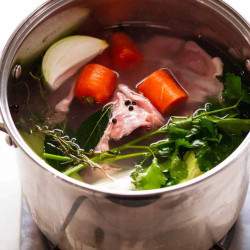Fill pot: Place all the chicken stock ingredients into a large stockpot (7 litre / 7 quarts+). Fill with 3 litres / 3 quarts of cold water, which should just about cover the bones. (Note 3)
Scoop off scum: Bring to a boil on medium-high heat. Scoop off and discard any foam that collects on the surface using a ladle (this helps make stock clear).
Simmer 3 hours: Turn stove down to low and simmer for 3 hours with no lid. The stove should be low enough so the surface is barely rippling and you just get a gentle bubble every now and then. Too rapid boiling = murky stock.
Strain: Using a lid to hold the bones and vegetables in the pot, pour the stock through a fine sieve into another pot or large bowl. (Alternatively, scoop out the solids first with a slotted spoon and then strain.)
Goal: You should end up with 2 litres / 2 quarts of stock. If you have more than about 2.25 litres / quarts, reduce by simmering on low (else the stock will be too weak). If you have less than 2 litres / quarts, top up with water.
Fill jars/containers: Measure out into containers for storage and faster cooling. (I do multiples of 1 cup)
Cool: Allow to cool on the counter then refrigerate. This will make any fat rise to surface and solidify.
Discard fat: Scrape fat off the surface and discard.
Ready to use! This stock is equivalent in strength to store-bought stock, so it can be used 1:1 in any recipe calling for chicken stock.
Store for 5 days in the fridge or freezer for 6 months. (Note 6)
Salt adjustment (Note 5): Homemade stock is unsalted whereas store-bought stock is salted. Add ¼ tsp salt for every 1 cup homemade chicken stock (250ml) to match the salt level of store-bought low sodium chicken stock.
To use: Cold stock has a jellied consistency (Note 4). It takes barely a minute to turn liquid on a medium-high stove, or microwave. You can also just add it in jelly form straight into dishes, but sometimes you may need to liquify it to measure.
